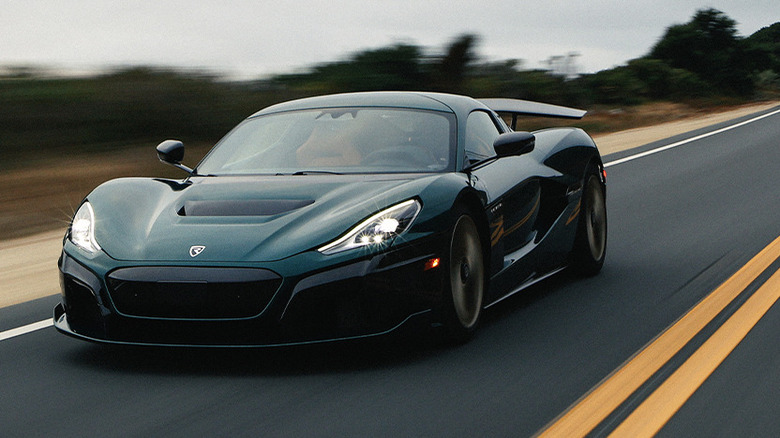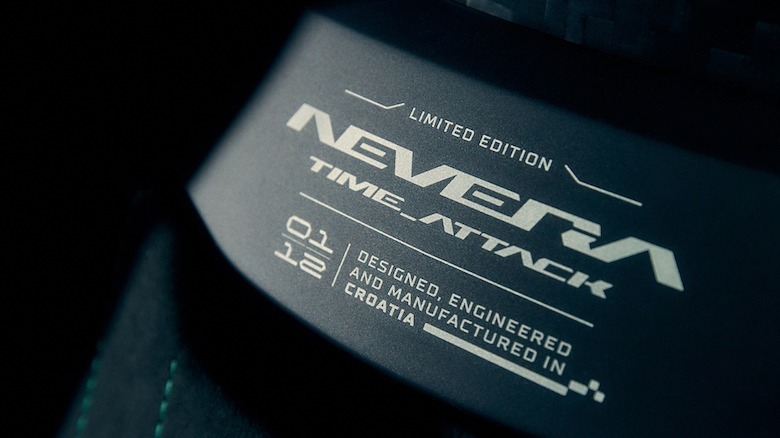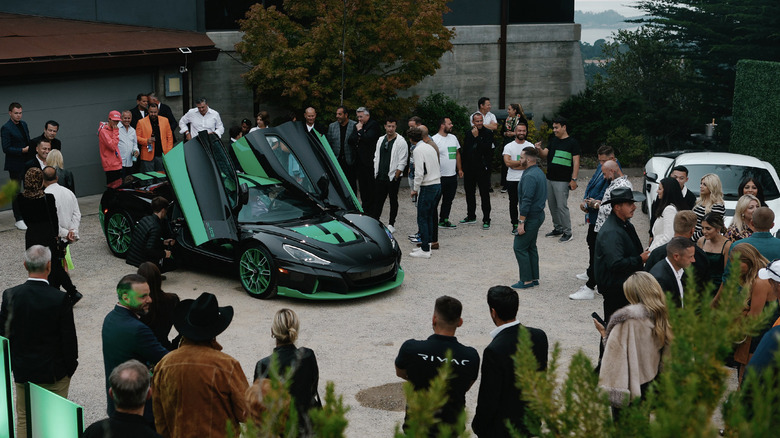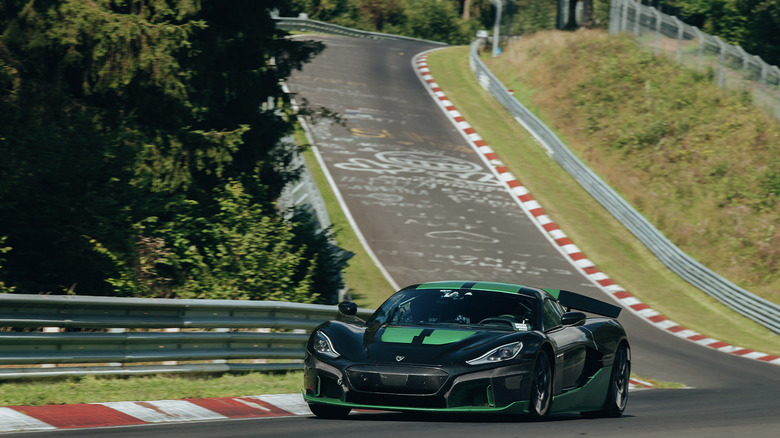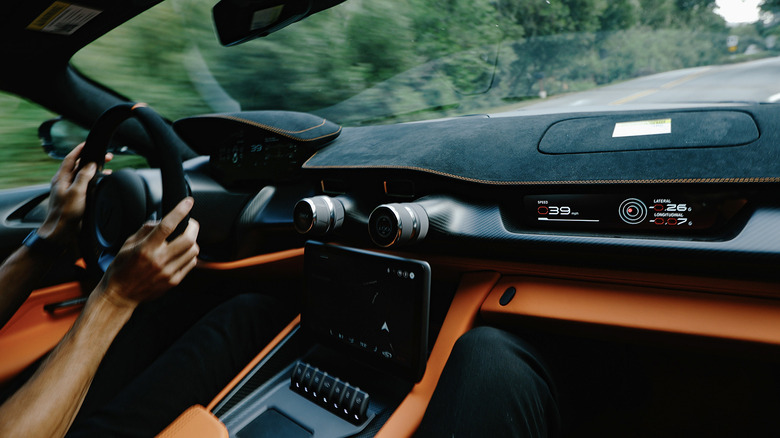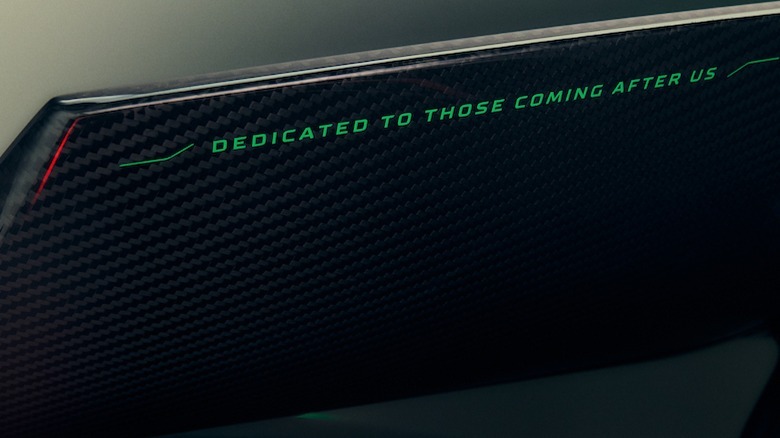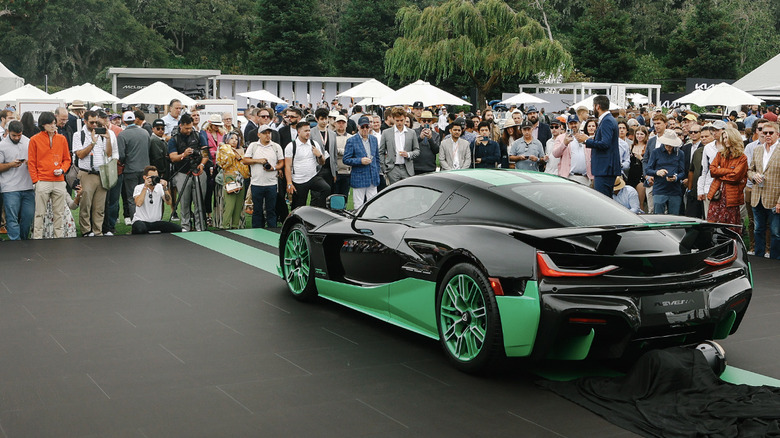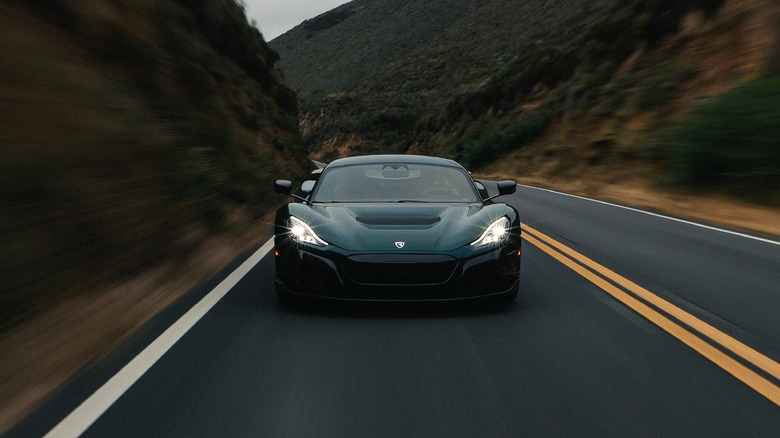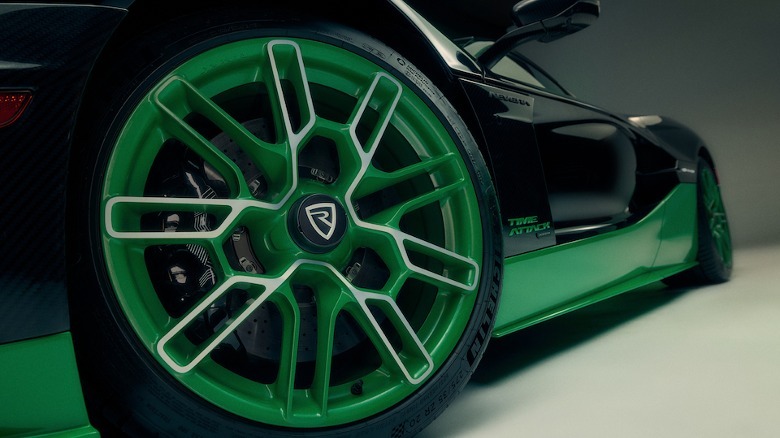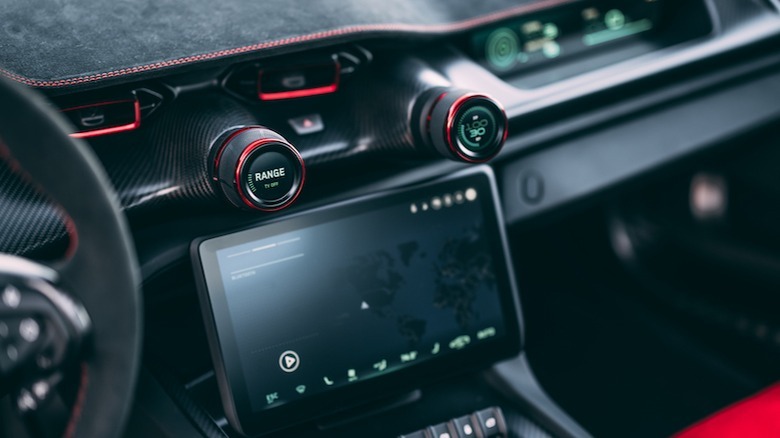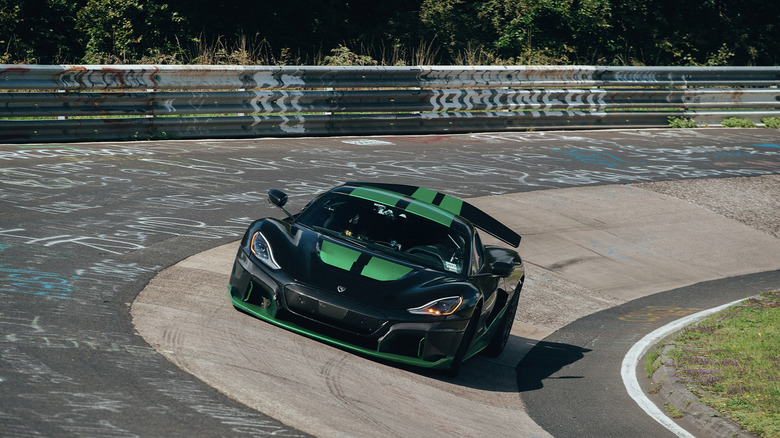Driving The Rimac Nevera Time Attack Edition: Is It Simply Too Fast?
For insurance purposes, Rimac Automobili requires factory development and test driver Goran Dr'ndak to ride shotgun for every media drive experience of the all-electric Nevera hypercar. Not a bad idea, I can admit, in the fastest production vehicle ever built—one that can easily quintuple legal speed limits in under five seconds of mind and physics-bending acceleration.
Dr'ndak advises to push my thick skull back into the headrest before I punch the go pedal the first time. For once, I listen as he walks me through the launch control protocol: Much easier than most internal-combustion cars, in this case just floor the brake, then the accelerator, and sidestep the brake. Simple enough, but I recommend taking that time to prepare mentally and physically for the oncoming onslaught of true breakneck speed. Even fully braced, my eyes crush back into their sockets, vision melting into a rush of compressed corpuscles.
Rimac unveiled a new Nevera special edition at this year's iteration of The Quail, A Motorsports Gathering on the very same day that a different car, albeit bedecked in a similar Time Attack livery, set a new production vehicle lap record of 7:05:298 on the Nürburgring Nordschleife. I'm behind the wheel of another of these one-of-12 hypercars capable not only of setting the fastest 0-60 and quarter-mile times of any production vehicle in the history of the world—but also one with the handling prowess to conquer one of the most challenging racing circuits ever designed. Fittingly, the roads of Monterey and Carmell Valley feel entirely inappropriate for this kind of fun.
Unbelievable power, without the drama
But I expected the acceleration to border on painful. Electric cars long ago made jerk commonplace as a scientific term for the instantaneous rate of change of acceleration—even if equally as descriptive for the average Tesla driver in West LA—and I recently tested the Lucid Air's highest-spec Sapphire trim in the Santa Monica Mountains. As much as the Sapphire blew my mind with three motors, a claimed output of 1,200 horsepower, and a 0-60 time only a tenth off the Rimac's, this Nevera Time Attack is, somehow, even more impressive. And not just because of the $2.2 million starting price tag or the ruthless, unrelenting acceleration, but because of how little drama the entire performance actually produces.
Launching a Dodge Demon down a drag strip, for example, requires a complex routine of tire warmup burnouts, transmission braking, and perfect timing to prevent any wheelslip that might ruin a quarter-mile time. Not so with the Nevera. Even shod in relatively tame Michelin Pilot Sport 4S tires, rather than the Cup 2 R rubber the Nürburgring car wore in that record-setting attempt, asking for every last horsepower and lb-ft of torque from the quad electric motors somehow elicits zero complaints from the tires. No chirping, no squealing, and no smoke on our merry way into triple (read: criminal) digits.
As much as I could have cogitated this new level of acceleration, that refinement makes up most of the conversation as Dr'ndak walks me through the car's controls. Not just Alcantara on nearly every surface to reinforce the sense of luxury a multi-million-dollar hypercar commands, either, but the way various drive modes entirely shift the character and characteristics of the driving experience.
Real-time measurements of wheel torque
Electric motors allow Rimac to finetune power delivery much more discretely than internal-combustion powerplants. Those require time to spin up into peak power, as explosions of oxygen and fuel blast pistons up and down in a dance of opposing forces then routed through gears and shafts and eventually into wheels and tires and finally the ground. With an electric motor at each wheel, the Nevera's driveline can far more quickly measure real-time traction and adjust power delivery accordingly. Rimac claims the all-wheel-drive system can make 100 measurements of torque per second—and I believe it, convinced entirely by the lack of fuss and drama during the hardest pull of my life.
The Nevera's official ratings of 1,914 horsepower and 1,741 lb-ft of torque sound impressive enough on paper, as do straight-line records including a 0-60 time of 1.74 seconds on the way to a quarter-mile in 8.26 seconds. Rimac also set out to smash the 0-249-0 time with a best time of 29.93 seconds, over one second better than the previous record holder (the Koenigsegg Regera, which actually retook the record a couple of months later).
Real-world sensory overload during every clobbering I repeatedly subject myself to essentially renders such numbers almost entirely meaningless. Just as importantly, Dr'ndak points out, I can play with shock damper, steering, brake, and power delivery modes on the fly to smooth out road imperfections, firm the suspension up into a canyon scalpel, and even select a fully rear-wheel-drive drift mode. The goal, as the Nevera's more subtle exterior styling suggests amid an increasingly aggressive hypercar design era, is to produce a multi-headed beast equally happy loping along in town, on the highway, in the canyons, or on the track. An EPA range estimate of 287 miles supports the touring mentality, though succumbing to irresistible urges will undoubtedly cleave into that figure significantly.
A smooth hyper-GT
The Time Attack edition celebrates the Nürburgring run and over 20 other acceleration and deceleration production car records set earlier in the year, with a new color scheme that harkens back to eponymous Rimac founder and CEO Mate Rimac's personal E30 BMW. Somewhat hilariously, Dr'ndak explains that he was driving when the engine on that Bimmer blew originally, setting Rimac on the path towards an electric powertrain swap that went on to establish a world record as the fastest accelerating electric car in the world back in 2012.
The twelve buyers of a Nevera Time Attack get the choice of an exclusive Squadron Black paint job with Lightning Green stripes inspired by that BMW. Other customers have specced Rimac Racing Red, Stiniva E-Blue, and even exposed carbon fiber for the entire body. Vertex alloy wheels and lettering on the bottom of the rear wing that reads "Dedicated to those coming after us" round out the exterior cues, while the interior receives plenty of black Alcantara, green contrast stitching, and badges galore celebrating the achievements and build numbers.
A few interior details remind me that Rimac also now runs Bugatti, as part of a multi-pronged deal with Volkswagen AG and Porsche. Digital readouts for power output and temperature built into tiny knobs might not exactly match the Chiron Super Sport, but no other car I've driven shares the same aesthetic. A crisp infotainment system with touchscreens to the left and right of the steering wheel and dash depart from the Bugatti-ness, though, and the overall forms actually create a somewhat less radical sensation than the Nevera's performance might suggest. Suffice to say, we've come a very long way from an E30 project car, very quickly.
Trust the ghost in the machine
That Nürburgring record lap cut over 20 seconds off the previous EV production time set by a Tesla Model S Plaid equipped with the optional Track Pack. As Dr'ndak explains, though, a hot day in Germany, even for August, meant that the Cup 2 R tires started to oil up a bit due to the weight and power adding up over the course of seven-plus hard minutes. Watching the video of Croatian racecar driver Martin Kodrić blasting through the forest, more slip and slide becomes more apparent deeper and deeper into the lap, the car often overstepping curbs entirely in the last handful of corners.
On our drive through Carmel Valley, I made the journalistically mandatory sprint up the famed Laurales Grade that connects Carmel to the base of Weathertech Raceway Laguna Seca. At the bottom of the hill, Dr'ndak cautioned me to slow down and open up a gap. Sure enough, even after losing sight of the cars in front before pushing through a few slaloms, we caught up in only a few seconds. And then again, and again.
I spotted a break in opposing traffic, finally, and turned around to stop on the side of the road hoping that we might get lucky. Pulling out a few minutes later, knowing full well what awaited down the hill, I started to actually hustle through corners, hard left-foot braking to set the nose, then tipping into throttle (still not sure what to call it?) with more and more confidence. Dr'ndak appeared to approve, then suggested we step up to Sport mode and allow the Nevera's torque vectoring to help me out a bit.
All of a sudden, the Nevera's skateboard chassis developed another personality. Instead of flatly rounding through corners with gobs of grip, the suspension squatted noticeably onto a happier outside rear tire as I punched out into straightaways. The Nevera overbalances torque for the rear wheels, so both front motors are rated at 303 horsepower and 207 lb-ft each, while the rears can pump out 603 hp and 664 lb-ft each. Similarly, regenerative braking shifted weight through the front tires more aggressively—an entirely different dance now underway, though cut short once again by the presence of pesky drivers out for a pokey cruise on public roads. These people, I swear.
Summoning the audacity to drift
At the bottom of the hill, I reached over and tentatively selected Drift mode, which predictably unleashes full power for the rear wheels but zero for the front while also allowing for less traction control intervention. Again allowing for a wide break in traffic, I cracked right and set the Nevera into a wide slide, Dr'ndak gasping, grasping for the door handle, maybe yelling just a bit. About 70 feet of medium throttle and maybe a hint of tire smoke later, feathering out of countersteer easily brought us back into line.
I looked over at Dr'ndak, grinning. He exhaled a sigh of relief, then proceeded to explain that the programming allows enough yaw without cutting power to drift. But as with all electric cars, a certain amount of intervention is required to prevent instantaneous torque from spinning the wheels up to infinite revs immediately. And sometimes, because the Nevera's center of inertia rides so low, letting off the go pedal can cause the tires to immediately catch traction again, then jump into a gnarly spin the opposite direction (something, as it turns out, I experienced the very next week in the new 2024 model year Polestar 2).
Rimac's programming allows for more fun—and crucially, more predictability while drifting—than the Polestar (which, to be fair, still delivers the fun factor for a rear-wheel-drive commuter EV). But where Polestar and, to an even greater extent, the Lucid Air prioritize a smooth ride with spacious interiors that offer seating for five, the Nevera still hews closely to the hypercar formula. The cockpit, though not constrained by a mid-mounted engine, snugs both driver and passenger into a swanky cocoon. In the softest drive modes, a fair amount of tire noise still hums in, as does the occasional pitter-patter of pebbles so common in carbon-fiber and aluminum monocoques.
That's not to say the Nevera can't serve as a grand tourer, just that the Sapphire and other "normal" EVs prioritize the elimination of NVH more. But none will corner and squat and drift as well as the Nevera, I have no doubt, even if very few owners will ever come close to pushing those limits. Maybe if any do, the 12 Time Attack buyers will be more likely to enjoy some such shenanigans. Whether Rimac should bear any responsibility for putting such great power in the hands of the general public remains a legitimate question for debate: Is this car, simply put, too powerful for public roads? Hopefully, the enforced scarcity and exorbitant cost will prompt owners to drive responsibly.
The mystery behind Mate Rimac's rise
My own time irresponsibly enjoying the Nevera's multiple personalities helps to explain, at least a little, the rise of Mate Rimac as a major player in the automotive landscape. But I still handed back the Nevera wondering what, more precisely, prompted VAG and Porsche to give this seeming upstart billions of dollars—not to mention control of Bugatti. The Nevera can set world records in a straight line and on real racing circuits alike, but the ungodly power and impressive tech still border on marginal gains rather than revolutionary leaps and bounds. I suspect more must be on the way from Rimac, beyond the already game-changing conceptualization and realization of just how much electric motors transform the ability to control traction in a multi-million-dollar hypercar.
Without a doubt, a better Nürburgring lap time will happen whenever weather permits. The next giant step in performance may require new tire tech, though, and pondering the question of how much faster the next Rimac or Bugatti might accelerate or corner already gives me a headache. And I can report, after ripping the Nevera around Carmel and Monterey, all those g forces front, rear, and lateral combined to leave my neck seriously sore for about two days.
